Cub Cadet 1027 Operator's Manual
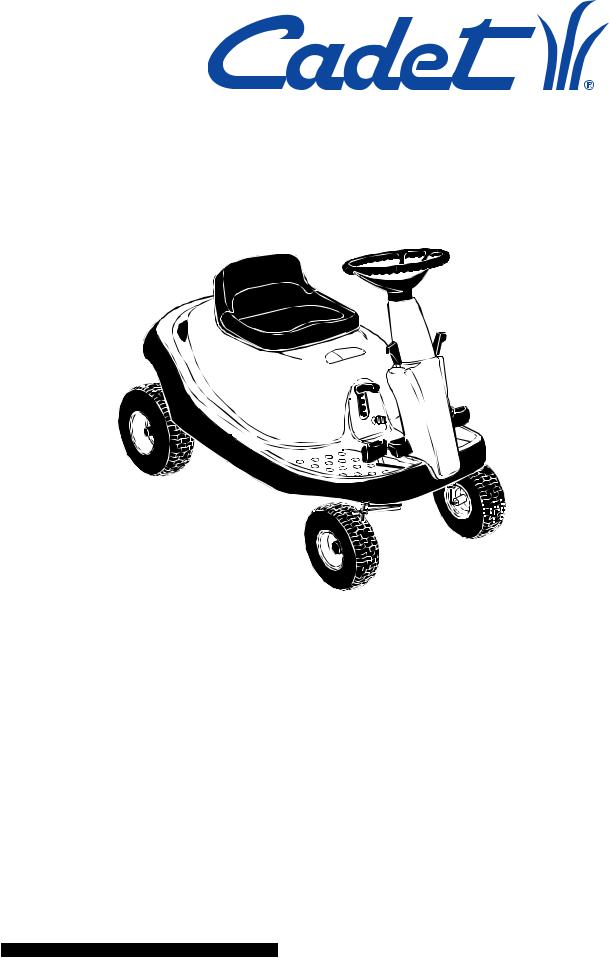
Operator’s Manual
Riding Mower
Internal Bagging System
Model 1027 (13A-328-101)
IMPORTANT: Read safety rules and instructions carefully before operating equipment.
Warning: This unit is equipped with an internal combustion engine and should not be used on or near any unimproved forestcovered, brush-covered or grass-covered land unless the engine’s exhaust system is equipped with a spark arrester meeting applicable local or state laws (if any). If a spark arrester is used, it should be maintained in effective working order by the operator. In the State of California the above is required by law (Section 4442 of the California Public Resources Code). Other states may have similar laws. Federal laws apply on federal lands. A spark arrester for the muffler is available through your nearest engine authorized service dealer or contact the service department, P.O. Box 368023 Cleveland, Ohio 44136-9722.
CUB CADET CORP. P.O. BOX 368023 CLEVELAND, OHIO 44136-9722
PRINTED IN U.S.A. |
FORM NO. 770-10094B.fm |
|
(12/99) |
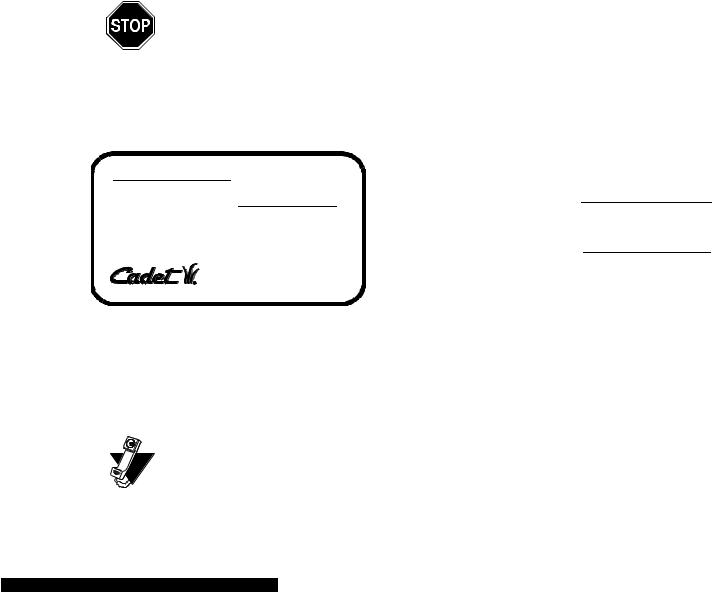
TABLE OF CONTENTS |
|
Content |
Page |
Important Safe Operation Practices................................................................... |
3 |
Slope Gauge...................................................................................................... |
6 |
Assembling Your Riding Mower ......................................................................... |
7 |
Know Your Riding Mower................................................................................... |
9 |
Operating Your Riding Mower............................................................................ |
11 |
Making Adjustments .......................................................................................... |
13 |
Servicing Your Rider Mower .............................................................................. |
15 |
Maintaining Your Riding Mower ......................................................................... |
17 |
Off-Season Storage ........................................................................................... |
19 |
Troubleshooting................................................................................................. |
20 |
Parts List............................................................................................................ |
22 |
FINDING MODEL NUMBER
This Operator’s Manual is an important part of your new riding mower. It will help you assemble, prepare and maintain the unit for best performance. Please read and understand what it says.
Before you start assembling your new equipment, please locate the model plate on the equipment and copy the information from it in the space provided below. The information on the model plate is very important if you need help from our Customer Dealer Referral line.
•You can locate the model plate by pivoting the cover upward and looking under the frame. A sample model plate is explained below. For future reference, please copy the model number and the serial number of the equipment in the space below.
(Model Number) |
(Serial Number) |
Copy the model number here: |
|
||
|
|
|
|
CUB CADET CORP. |
Copy the serial number here: |
|
|
|
|
P.O. BOX 368023 |
|
|
CLEVELAND, OHIO 44136 |
|
CALLING CUSTOMER SUPPORT
If you have difficulty assembling this product or have any questions regarding the controls, operation or maintenance of this unit, please call the Customer Dealer Referral Line.
Call 1- (800)-528-1009 to reach a Customer Support representative. Please have your unit’s model number and serial number ready when you call. See previous section to locate this information. You will be asked to enter the serial number in order to process your call .
2

SECTION 1: IMPORTANT SAFE OPERATION PRACTICES
This symbol points out important safety instructions which, if not followed, could endanger the personal safety and/or property of yourself and others. Read and follow all instructions in this manual before attempting to operate your rider mower. Failure to comply with these instructions may result in personal injury. When you see this symbol— heed its warning.
Your rider mower was built to be operated according to the rules for safe operation in this manual. As with any type of power equipment, carelessness or error on the part of the operator can result in serious injury. If you violate any of these rules, you may cause serious injury to yourself or others.
WARNING: The engine exhaust from this product contains chemicals known to the State of California to casue cancer, birth defects or other reproductive harm.
General Operation
•Read, understand, and follow all instructions in the manual and on the machine before starting. Keep this manual in a safe place for future and regular reference and for ordering replacement parts.
•Only allow responsible individuals familiar with the instructions to operate the machine. Know controls and how to stop the machine quickly.
•Do not put hands or feet under cutting deck or near rotating parts.
•Clear the area of objects such as rocks, toys, wire, etc., which could be picked up and thrown by the blade. A small object may have been overlooked and could be accidentally thrown by the mower in any direction and cause injury to you or a bystander. To help avoid a thrown objects injury, keep children, bystanders and helpers at least 75 feet from the mower while it is in operation. Always wear safety glasses or safety goggles during operation or while performing an adjustment or repair, to protect eyes from foreign objects. Stop the blade(s) when crossing gravel drives, walks or roads.
•Be sure the area is clear of other people before mowing. Stop machine if anyone enters the area. Never carry passengers.
•Disengage blade(s) before shifting into reverse and backing up. Always look down and behind before and while backing.
•Be aware of the mower and attachment discharge direction and do not point it at anyone. Do not operate the mower without either the entire grass catcher or the chute guard in place.
•Slow down before turning. Operate the machine smoothly. Avoid erratic operation and excessive speed.
•Never leave a running machine unattended. Always turn off blade(s), place transmission in neutral, set park brake, stop engine and remove key before dismounting.
•Turn off blade(s) when not mowing.
•Stop engine and wait until blade(s) comes to a complete stop before (a) removing grass catcher or unclogging chute, or (b) making any repairs, adjusting or removing any grass or debris.
•Mow only in daylight or good artificial light.
•Do not operate the machine while under the influence of alcohol or drugs.Watch for traffic when operating near or crossing roadways.
•Use extra care when loading or unloading the machine into a trailer or truck. This unit should not be driven up or down a ramp onto a trailer or truck under power, because the unit could tip over, causing serious personal injury. The unit must be pushed manually on a ramp to load or unload properly.
•Never make cutting height adjustment while engine is running, if operator must dismount to do so.
•Wear sturdy, rough-soled work shoes and closefitting slacks and shirts. Do not wear loose fitting clothes or jewelry. They can be caught in moving parts. Never operate a unit in bare feet, sandals, or sneakers.
•Check overhead clearance carefully before driving under power lines, wires, bridges or low hanging tree branches, before entering or leaving buildings, or in any other situation where the operator may be struck or pulled from the unit, which could result in serious injury.
•Disengage all attachment clutches, thoroughly depress the brake pedal, and shift into neutral before attempting to start engine.
•Your mower is designed to cut normal residential grass of a height no more than 10". Do not attempt to mow through unusually tall, dry grass (e.g., pasture) or piles of dry leaves. Debris may build up on the mower deck or contact the engine exhaust presenting a potential fire hazard.
Slope Operation
•Slopes are a major factor related to loss of control and tip-over accidents which can result in severe
3

injury or death. All slopes require extra caution. If you cannot back up the slope or if you feel uneasy on it, do not mow it.
•For your safety, use the slope gauge included as part of this manual to measure slopes before operating this unit on a sloped or hilly area. If the slope is greater than 15° as shown on the slope gauge, do not operate this unit in that area or serious injury could result.
Do:
•Mow up and down slopes, not across.
•Remove obstacles such as rocks, limbs, etc.
•Watch for holes, ruts or bumps. Uneven terrain could overturn the machine. Tall grass can hide obstacles.
•Use slow speed. Choose a low enough gear so that you will not have to stop or shift while on the slope. Always keep machine in gear when going down slopes to take advantage of engine braking action.
•Follow the manufacturer’s recommendations for wheel weights or counterweights to improve stability.
•Use extra care with grass catchers or other attachments. These can change the stability of the machine.
•Keep all movement on the slopes slow and gradual. Do not make sudden changes in speed or direction. Rapid engagement or braking could cause the front of the machine to lift and rapidly flip over backwards which could cause serious injury.
•Avoid starting or stopping on a slope. If tires lose traction, disengage the blade(s) and proceed slowly straight down the slope.
Do Not:
•Do not turn on slopes unless necessary; then, turn slowly and gradually downhill, if possible.
•Do not mow near drop-offs, ditches or embankments.The mower could suddenly turn over if a wheel is over the edge of a cliff or ditch, or if an edge caves in.
•Do not mow on wet grass. Reduced traction could cause sliding.
•Do not try to stabilize the machine by putting your foot on the ground.
•Do not use grass catcher on steep slopes.
Children
•Tragic accidents can occur if the operator is not alert to the presence of children. Children are often attracted to the machine and the mowing activity. Never assume that children will remain where you last saw them.
•Keep children out of the mowing area and in watchful care of an adult other than the operator.
•Be alert and turn machine off if children enter the area.
•Before and when backing, look behind and down for small children.
•Never carry children. They may fall off and be seriously injured or interfere with the safe machine operation.
•Never allow children under 14 years old to operate the machine. Children 14 years and over should only operate machine under close parental supervision and proper instruction.
•Use extra care when approaching blind corners, shrubs, trees or other objects that may obscure your vision of a child or other hazard.
•Remove key when machine is unattended to prevent unauthorized operation.
Service
•Use extreme care in handling gasoline and other fuels. They are extremely flammable and the vapors are explosive.
a. Use only an approved container.
b.Never remove fuel cap or add fuel with the engine running. Allow engine to cool at least two minutes before refueling.
c.Replace fuel cap securely and wipe off any spilled fuel before starting the engine as it may cause a fire or explosion.
d.Extinguish all cigarettes, cigars, pipes and other sources of ignition.
e.Never refuel the machine indoors because fuel vapors will accumulate in the area.
f.Never store the fuel container or machine inside where there is an open flame or spark, such as a gas hot water heater, space heater or furnace.
•Never run a machine inside a closed area.
•To reduce fire hazard, keep the machine free of grass, leaves or other debris build-up. Clean up oil or fuel spillage. Allow machine to cool at least 5 minutes before storing.
•Before cleaning, repairing or inspecting, make certain the blade and all moving parts have stopped. Disconnect the spark plug wire, and keep the wire away from the spark plug to prevent accidental starting.
•Check the blade and engine mounting bolts at frequent intervals for proper tightness. Also, visually inspect blade for damage (e.g., excessive wear, bent, cracked). Replace with blade which meets original equipment specifications.
•Keep all nuts, bolts and screws tight to be sure the equipment is in safe working condition.
•Never tamper with safety devices. Check their proper operation regularly. Use all guards as instructed in this manual.
•After striking a foreign object, stop the engine, remove the wire from the spark plug and thoroughly inspect the mower for any damage. Repair the damage before restarting and operating the mower.
4
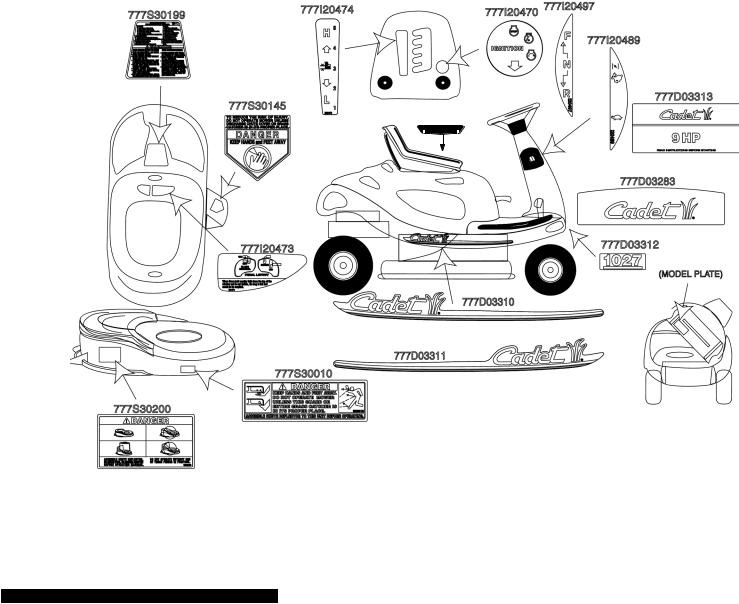
• Grass catcher components are subject to wear, |
• Observe proper disposal laws and regulations. |
|
damage and deterioration, which could expose |
Improper disposal of fluids and materials can harm |
|
moving parts or allow objects to be thrown. For your |
the environment and the ecology. |
|
safety protection, frequently check components |
a. Prior to disposal, determine the proper method |
|
and replace with manufacturer’s recommended |
to dispose of waste from your local office of |
|
parts when necessary. |
Environmental Protection Agency. Recycling |
|
• Mower blades are sharp and can cut. Wrap the |
centers are established to properly dispose of |
|
materials in an environmentally safe fashion. |
||
blade(s) or wear gloves and use extra caution when |
||
b. Use proper containers when draining fluids. Do |
||
servicing blade(s). |
||
not use food or beverage containers that may |
||
• Check brake operation frequently. Adjust and |
||
mislead someone into drinking from them. |
||
service as required. |
||
Properly dispose of the containers immediately |
||
• Muffler, engine and belt guards become hot during |
||
following the draining of fluids. |
||
operation and can cause a burn. Allow to cool down |
||
c. DO NOT pour oil or other fluids into the ground, |
||
before touching. |
down a drain or into a stream, pond, lake or |
|
• Do not change the engine governor settings or |
other body of water. Observe Environmental |
|
overspeed the engine. Excessive engine speeds |
Protection Agency regulations when disposing |
|
are dangerous. |
of oil, fuel, coolant, brake fluid, filters, batteries, |
|
|
tires and other harmful waste. |
•Illustrated below are the location and part numbers of all labels found on your rider mower. Please follow the instruction on these labels. For replacement labels, please order by the part numbers.
777I20800
 LIFT HERE
LIFT HERE
5
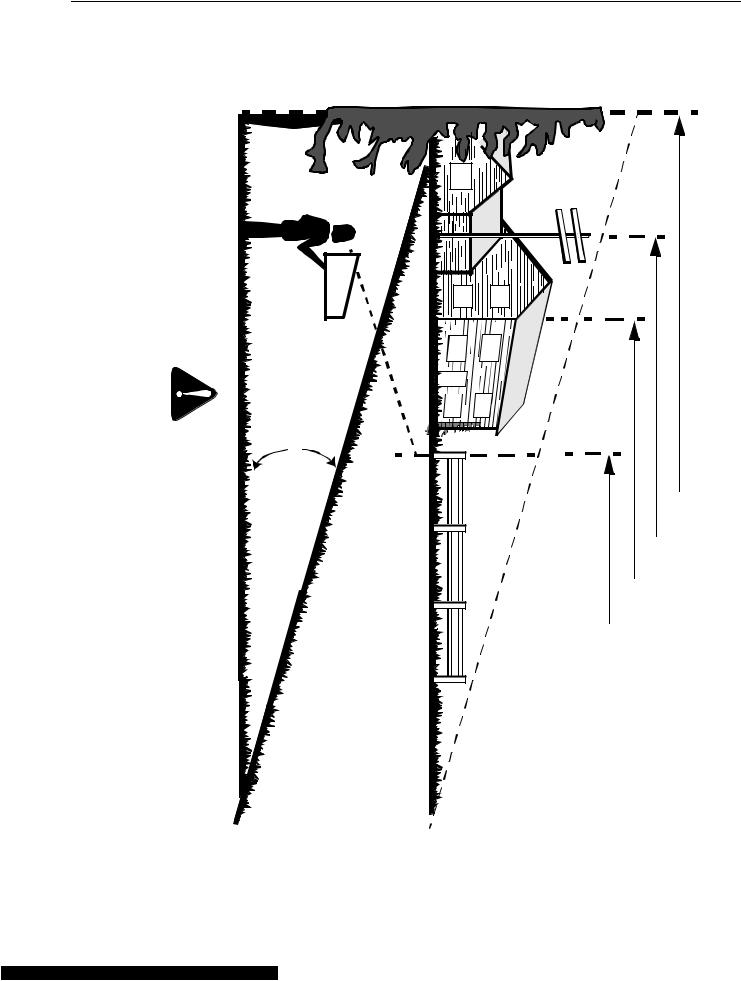
SECTION 2: SLOPE GUAGE
USE THIS PAGE AS A GUIDE TO DETERMINE SLOPES WHERE YOU MAY NOT OPERATE RIDER SAFELY:
theacross.slopesdownandupneverslopes,offacemowers BEHIND-WALK Operate |
sloffacetheacrossneverslopes,down.opesand up mowers RIDING Operate |
.injuryseriousinresultingslip,couldyouandfootingyourmaintain to fficultdi extremely is |
secauseandasuchonmowerbehind-walkaoperatingIf.injuryriousoverturn could mower riding A |
appofrise(adegrees15ofexcessinslopeeveryfeet1/2-2roximatelya with inclines on mow not Do |
WARNING |
15° |
F |
POSTFENCEAOR |
BUILDINGAOFCORNERA |
POLEPOWERA |
VERTICALAWITHLEVELTHISHOLDANDSIGHT |
|
|
|
|
|
|
|
O |
|
|
|
|
|
|
|
|
|
|
|
L |
|
|
|
|
|
|
|
|
|
|
|
D |
|
|
|
|
|
|
|
|
|
|
|
O |
|
|
|
|
|
|
|
|
|
|
|
N |
|
|
|
|
|
|
|
|
|
|
|
D |
|
|
|
|
|
|
|
|
|
|
|
O |
|
|
|
|
|
|
|
|
|
|
|
T |
|
|
|
|
|
|
|
|
|
|
|
T |
|
|
|
|
|
|
|
|
|
|
|
E |
|
|
|
|
|
|
|
|
|
|
|
D |
|
|
|
|
|
|
|
|
|
|
|
L |
|
|
|
|
|
|
|
|
|
|
|
I |
|
|
|
|
|
|
|
|
|
|
|
N |
|
|
|
|
|
|
|
|
|
|
|
E |
|
|
|
|
|
|
|
|
|
|
|
, |
|
|
|
|
|
|
|
|
|
|
|
R |
|
|
|
|
|
|
|
|
|
|
|
E |
|
|
|
|
|
|
|
|
|
|
|
P |
|
|
|
|
|
|
|
|
|
|
|
R |
|
|
|
|
|
|
|
|
|
|
|
E |
|
|
|
|
|
|
|
|
|
|
|
S |
|
|
|
|
|
|
|
|
|
|
|
E |
|
|
|
|
|
|
|
|
|
|
|
N |
|
|
|
|
|
|
|
|
|
|
|
T |
|
|
|
|
|
|
|
|
|
|
|
I |
|
|
|
|
|
|
|
|
|
|
|
N |
|
|
|
|
|
|
|
|
|
|
|
G |
|
|
|
|
|
|
|
|
|
|
|
A |
|
|
|
|
|
|
|
|
|
|
|
1 |
|
|
|
|
|
|
|
|
|
|
|
5 |
|
|
|
|
|
|
|
|
|
|
|
° |
|
|
|
|
|
|
|
|
|
|
|
S |
|
|
|
|
|
|
|
|
|
|
|
L |
|
|
|
|
|
|
|
|
|
|
|
O |
|
|
|
|
|
|
|
|
|
|
|
P |
|
|
|
|
|
|
|
|
|
|
|
E |
|
|
|
|
|
|
|
it slope, |
.feet) 10 |
|
|
|
|
|
|
TREE |
6
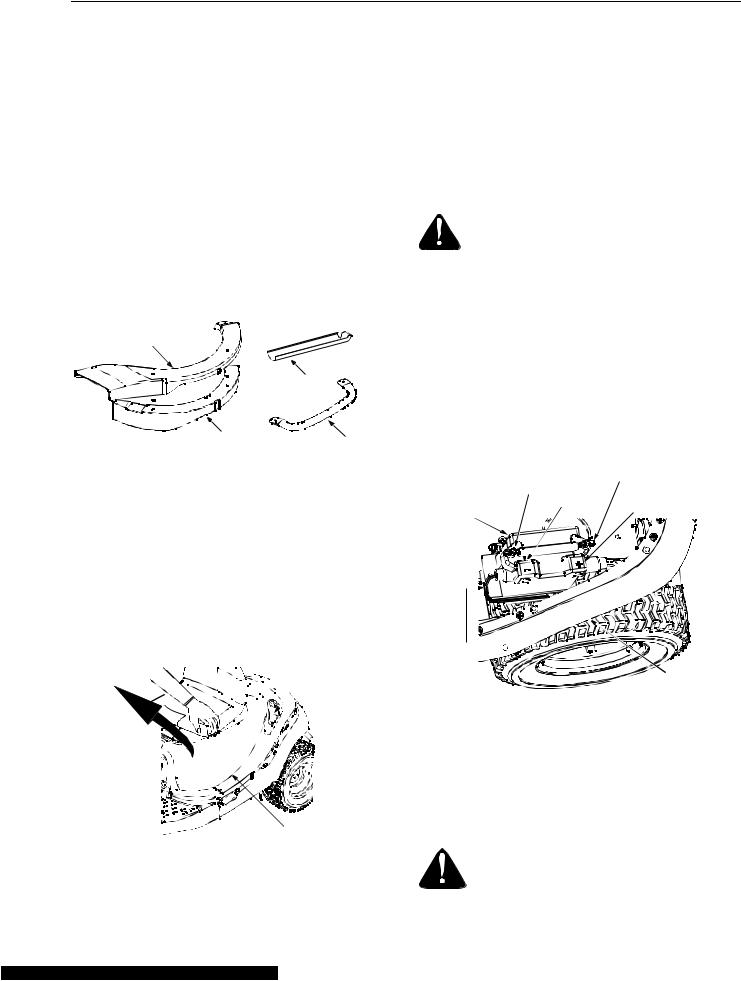
SECTION 3: UNPACKING & ASSEMBLING YOUR RIDER MOWER
•Remove all screws and staples from crate.
•Holding the sides of the crate firmly, lift the top of the crate up and keep it aside. Avoid tire punctures.
•Remove and discard plastic bag covering the unit.
•Lift the rear of the mower and clear the bottom of the crate. Repeat for the front.
•Be sure parking brake is disengaged; roll unit out of the crate’s way.
Loose Parts
•Remove loose parts from the grass catcher and/or the crate very carefully. Refer to Figure 1.
1.Operator’s manual (not shown in Figure 1)
2.Mulching plug & side-discharge chute
3.Oil drain sleeve
4.Ignition keys (not shown in Figure 1)
5.Bumper (optional)
Side-Discharge
Chute
Oil Drain
Sleeve
Mulching |
Bumper |
|
Plug |
||
|
Figure 1
Attaching Battery Cables
The battery is located under the hood assembly above the left rear wheel. Refer to Figure 3 .
•To access the battery, lift the hood assembly from the left side of the hood only. Stand on the right side of the unit and pivot the hood assembly towards you until fully opened. See Figure 2 .
CAUTION: Do not lift the hood assembly by the two vent openings located behind the seat.
Vent






 Opening
Opening
Hood Assembly
Figure 2
•Remove both wing nuts securing the battery and cover to the battery hold-down rods. See Figure 3 .
•Remove red and black insulation caps from battery terminals. See Figure 3
•Remove battery terminal screws with a Phillips screw driver or a 10 mm. socket wrench.
•Attach the red battery cable to the positive terminal (marked +), and the black battery cable to the negative terminal (marked -) on the battery. See Figure 3 .
•Align the cables with the slots in the battery cover and tighten the screws on the battery terminals.
WARNING: Press the battery cables against side of battery so that these do not make contact with flange of rider frame when it is opened or closed.
•Reassemble the battery cover to the hold-down rods on two ends with the two wing nuts removed earlier. Check to ensure that the cables pass easily through slots in cover.
•Place your right hand on the left side of the seat and slowly lower the hood assembly untill it is fully closed.
CAUTION: Do not place your hand around the bottom edge of the hood assembly; it may get pinched between the hood assembly and grass catcher or the frame rail.
|
|
|
Wing |
|
|
|
Wing |
|||||||||||||||
|
|
|
|
|
|
Nut |
||||||||||||||||
|
|
|
|
Nut |
Negative |
|
|
Positive |
||||||||||||||
Battery |
Terminal |
|
|
|||||||||||||||||||
|
|
Terminal |
||||||||||||||||||||
Cover |
|
|
|
|
|
|||||||||||||||||
|
|
|
|
|
|
|
|
|
|
|
|
|
|
|
|
|
|
|||||
|
|
|
|
|
|
|
|
|
|
|
|
|
|
|
|
|
|
|
|
|
|
|
|
|
|
|
|
|
|
|
|
|
|
|
|
|
|
|
|
|
|
|
|
|
|
|
|
|
|
|
|
|
|
|
|
|
|
|
|
|
|
|
|
|
|
|
|
|
|
|
|
|
|
|
|
|
|
|
|
|
|
|
|
|
|
|
|
|
|
|
|
|
|
|
|
|
|
|
|
|
|
|
|
|
|
|
|
|
|
|
|
|
|
|
|
|
|
|
|
|
|
|
|
|
|
|
|
|
|
|
|
|
|
|
|
|
|
|
|
|
|
|
|
|
|
|
|
|
|
|
|
|
|
|
|
|
|
|
|
|
|
|
|
|
|
|
|
|
|
|
|
|
|
|
|
|
|
|
|
|
|
|
|
Battery
Cable
Rider
Frame
Figure 3
Attaching Side-Discharge Chute
Your riding mower is shipped to you with the grass catcher fully assembled on the unit. A side-discharge chute and a mulching plug are included as loose parts. Follow the instructions below to attach the sidedischarge chute.
WARNING: Do not operate the mower if any one of the grass catcher, discharge chute or mulching plug is not firmly installed on the mower.
7
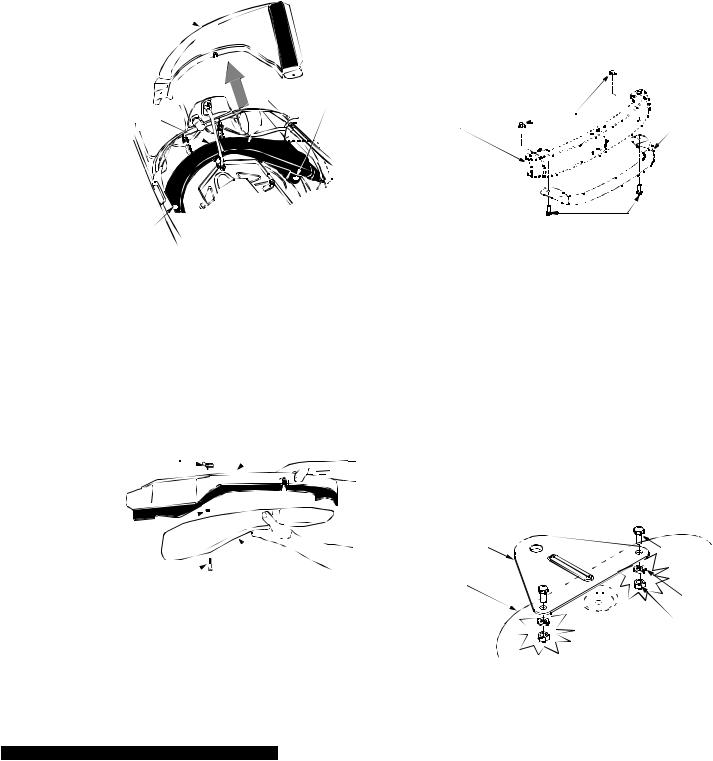
•Pivot the hood assembly up and lower the cutting height adjustment lever to the lowest position.
•Remove the two wing nuts (A and B in Figure 4 ) from two ends of the grasscatcher chute.
•Loosen the two wing nuts (C and D in Figure 4 ) in the middle of the chute. Do not remove. All four wing nuts hold the chute to the deck frame.
•Slide the grasscatcher chute to the right and out of the deck frame. Slide the side-discharge chute in and place it on the deck so that the four wing nut positions align with those on the deck.
•Reinsert wing nuts A and B. Tighten to secure. Tighten the two wing nuts C and D.
Grass Catcher
Chute
|
|
Side- |
|
|
|
Discharge |
Wing |
|
|
Chute |
Nut B |
Wing |
|
||
Nut D |
|
||
|
|
|
|
•To attach the mulching plug now to the unit, follow instructions on previous page to attach sidedischarge chute to the deck.
•Place wing nut on each of the hex bolts and thread a few turns. See Figure 5 . Check that the mulch plug is aligned correctly within the discharge chute.
•Tighten both wing nuts
Attaching Bumper
•Remove bumper from the grass catcher.
•Loosen and remove the two hex bolts and lock nuts from the front rail on the rider mower. See Figure 6 .
•Align the two holes on the bumper tube with the corresponding holes on the rider frame (from where you removed the hardware). See Figure 6.
•Re-insert the two hex bolts through the bumper and the rider frame and secure with the two lock nuts. See Figure 6 .
Rider Frame |
|
k |
|
|
|
||
oc |
|
||
Rail |
L |
t |
Bumper |
|
u |
||
N |
|
||
|
Wing |
Wing |
Nut C |
Nut A |
|
Figure 4
Attaching Mulch Plug
While operating your rider mower, you have three options: (i) to collect grass clippings in the grass catcher, (ii) to discharge grass clippings on the side, or (iii) to mulch grass and recirculate clippings back to the lawn. For the third option, attach the mulching plug to the side-discharge chute and then to the deck.
•Put two hex bolts through the mulching plug at the respective openings. See Figure 5 .
Side Discharge Chute
|
Wing Nut |
|
|
|
|
|
|
|
|
|
|
|
|
|
|
|
|
|
B |
|
|
|
|
|
|||
|
|
|
|
|||
Speed |
A |
|||||
Nut |
|
|
|
|
|
|
|
Hex Bolt |
|
|
|
Mulching |
|
|
|
|
|
|||
|
|
|
|
Plug |
||
Figure 5
•Place speed nuts over the hex bolts.
•Insert the plug into the side-discharge chute aligning the two slots on two sides of the sidedischarge chute with those on the mulching plug.
 Hex Bolt
Hex Bolt
Figure 6
Attaching Hitch Plate
The hitch plate was loosely attached to the rear frame of the rider for shipping purposes.
•Loosen the nut attaching the hitch plate to the frame and swing the plate outward. Make sure that the wider side of the hitch plate aligns with the rear frame as shown in Figure 7 .
•Remove the hex bolt, lock washer and hex nut from the other end of the rear frame. Save the hardware.
•Align the hole on the hitch plate with the corresponding hole on the rear frame assembly (from where you removed the hardware).
•Re-insert the hex bolt through the hitch plate and the rear frame. Secure with the lock washer and hex nut removed earlier. See Figure 7 . Tighten both sets of hardware.
Hitch Plate
 Hex Bolt
Hex Bolt
Rear
Frame 
 Lock
Lock
Washer
Hex
Nut
Figure 7
8

SECTION 4: KNOW YOUR RIDER MOWER
Compare the illustrations in Figure 8 with your rider mower to familiarize yourself with the location of various controls and adjustments. The operation of any rider mower can result in foreign objects being thrown into the operator’s eyes, causing severe eye damage. Always wear safety glasses before operating the mower, or while performing any adjustments or repairs on it.
Seat |
Throttle/Choke |
|
Control |
||
|
Grass Fill Level
Indicator
Ignition 
Switch
Side Discharge
Chute
Cutting
Deck
Parking |
Grass |
|
Catcher |
||
Brake |
||
|
Blade
Engagement
Pedal
Blade
Lock
Steering Wheel
Shift Lever
Cutting Height
Adjustment Lever
Blade Engagement
Pedal
“Go” 

 Pedal Brake
Pedal Brake
Pedal
Hood
Assembly
 Engine
Engine
Battery
Figure 8
Throttle/Choke Control
Use to regulate the engine speed and to start the engine.
“Go” Pedal
Use to regulate the ground speed of the rider mower.
Ignition Switch
Use to turn the engine ON or OFF.
Shift Lever
Use to change direction of the mower.
Grass Fill Level Indicator
Use to determine the level of grass clipping in the bag and when to stop and empty it.
Parking Brake
Use to stop the mower from moving while parked.
Blade Engagement Pedal
Use to engage or disengage the blade.
Blade Lock
Use to lock blade at the engaged position.
9
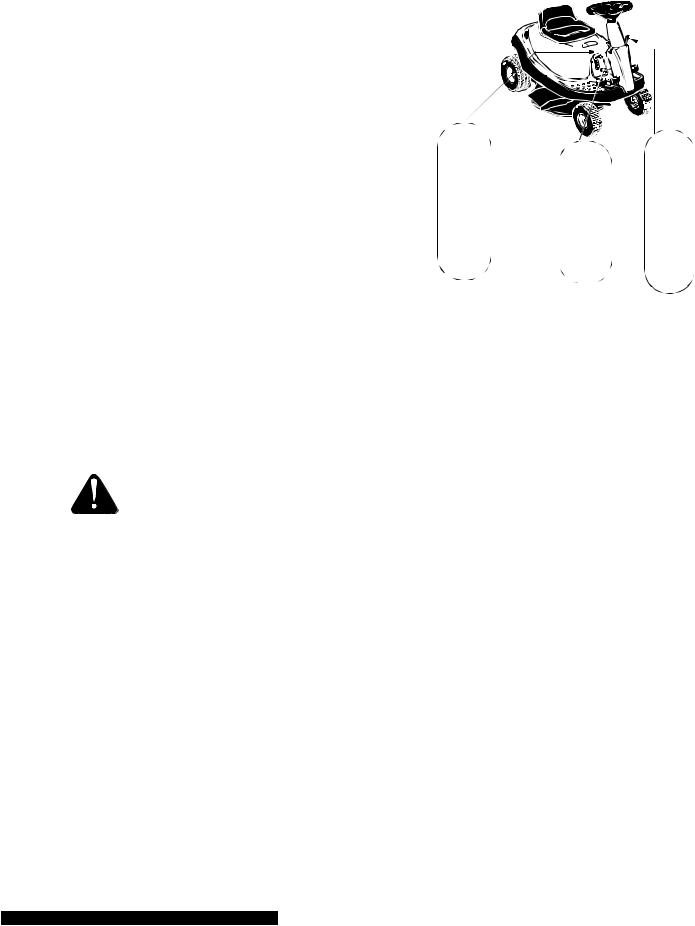
Cutting Height Adjustment Lever
Use to raise and lower the cutting deck which determines the cutting height.
Brake Pedal
•Before you move the shift lever to any of the positions, depress the brake pedal and stop the unit. Keep your foot on the brake pedal.
Use to stop the mower’s forward or reverse motion.
Stopping Mower
•Release blade engagement pedal all the way.
•Release the "Go" pedal and depress the brake pedal.
•When the mower comes to a complete stop, place the shift lever in neutral.
•Engage the parking brake by pulling up on the parking brake knob.
•Turn the ignition key to OFF position and remove the key.
Safety Interlock
This unit is equipped with a safety interlock system for your protection. The interlock safety switches are connected to the brake pedal, the blade engagement pedal, the shift lever, and the seat.
CHOKE
Cutting
Height
Shift
Lever
The purpose of the safety interlock system is threefold:
a.to prevent the engine from starting unless the brake pedal is depressed and the blade engagement pedal is disengaged;
b.to shut off the engine if the blade pedal is not disengaged when the shift lever is put into reverse; and
c.to shut the engine off when the operator leaves the seat without engaging the parking brake.
WARNING: To avoid the risk of serious injury, do not operate the rider mower if the interlock system is malfunctioning.
•Remove objects that could be thrown by the blade(s).
•Know location and function of all controls.
•Be sure blade(s) and engine are stopped before placing hands or feet near blade(s).
•Before leaving operator's position, disengage blade(s), place the shift lever in neutral, engage parking brake, shut engine off and remove key.
Using Shift Lever
The shift lever is used to regulate the direction of your rider mower. It can be set at forward, neutral, or reverse settings. These settings, marked as F, N,and R respectively, are located next to the shift lever on the unit. See Figure 9.
Figure 9
•Move the lever outwards (left) to remove the locking pin from the lever and slide the lever to the position desired. Look at the rear and make sure the path is free of obstacles before positioning the shift lever to the reverse.
•Do not force the shift lever. If it does not shift, release the brake pedal slightly to line up the shifting collar in the transmission, then try to move the shift lever.
•Slowly release the brake pedal and take your foot off the pedal. Always make sure that there is no one in the way when you run the mower.
Grass Fill Level Indicator
This indicator was designed to add convenience to your riding mower. While the mower is running, air will flow through the discharge chute and into the grass catcher. If the grass catcher is empty, air flows through easily pushing the ball up. If the grass catcher is full, air does not flow through it allowing the ball to fall. So if you see the ball in the grass catcher fill level indicator falling down, you should stop the mower and empty the bag.
10
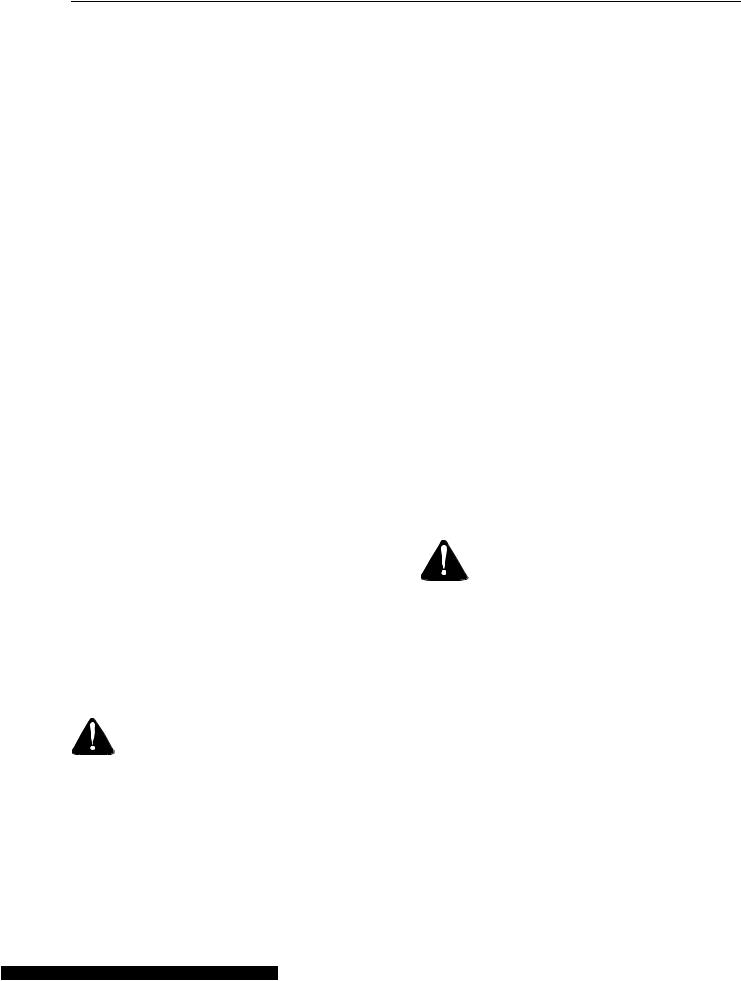
SECTION 5: OPERATING YOUR RIDER MOWER
Using Throttle/Choke Control
The throttle/choke control is used to increase or decrease the speed of the engine.The FAST and the SLOW positions are marked with illustrations of a rabbit and a turtle respectively. See Figure 9.
•For normal operation and when using a grass catcher, move the throttle/choke control to the FAST position.
•For maximum charging of the battery and also for a cooler engine while running, move the throttle/ choke control to the FAST position.
•For transport and to tow pull-behind attachments, move the throttle/choke control to the SLOW position.
•Do not adjust the governor to increase or decrease the engine speed. The governor is set at the factory for maximum engine performance, and should not be altered.
Using Parking Brake
To engage parking brake
•Completely push the brake pedal down and stop the unit.
•With your right foot on the brake pedal, move the shift lever to the neutral position.
•Continuing to hold down the brake pedal with your right foot, pull up the parking brake knob. Make sure the parking brake holds the unit.
•Release the brake pedal. Stop the engine and remove the ignition key. Now your rider mower is parked.
To release the parking brake
•Depress the brake pedal. The parking brake will be automatically disengaged.
Before Starting
Service the engine with gasoline as described in the engine manual. Check oil level.
WARNING: Never fill fuel tank indoors, or when engine is running or hot. Do not smoke while filling up the gasoline tank.
Starting Engine
•Attach the wire to the spark plug.
•Depress the brake pedal with your right foot.
•Set throttle/choke control in the CHOKE position (all the way forward).
•Place the shift lever in the NEUTRAL position.
•Turn the ignition key to the START position. As soon as the engine starts, let the key return to the ON position.
•Move throttle/choke control out of CHOKE position and into FAST throttle position.
Starting Mower
•Depress the brake pedal so that the parking brake is disengaged.
•Place the shift lever in either the FORWARD or the REVERSE position as you desire. Look to the rear and check before backing up.
•Release the brake pedal.
•Depress the "Go" pedal.
•To stop, release the "Go" pedal and depress the brake pedal.
•Press the blade engagement pedal downward until the blades are turning.The blades can be engaged either while the mower is in motion or while it is standing.
NOTE: Your rider mower is equipped with a blade lock to keep the blade engaged without the operator having to depress the blade pedal continuously. See Figure 8 .
•To engage the blade lock: While pressing down on the blade pedal, push the blade lock down with your heel. It should click into the “blade engaged” position. To disengage the blade lock, simply push down on the blade pedal and release the lock.
WARNING: When the blades are engaged, keep feet and hands away from the discharge opening, the blades or any part of the deck.
Stopping Mower
•Release blade engagement pedal all the way.
•Release the "Go" pedal and depress the brake pedal.
•When the mower comes to a complete stop, place the shift lever in neutral.
•Engage the parking brake by pulling up on the parking brake knob.
•Turn ignition key to OFF position and remove it.
NOTE: Do not leave the key in the ON position when you are not operating the mower. Such action will drain the battery dead.
To Empty Grass Catcher
•Stop the mower completely, pull up on the parking brake knob and take the ignition key out. Get off the operator’s seat.
11
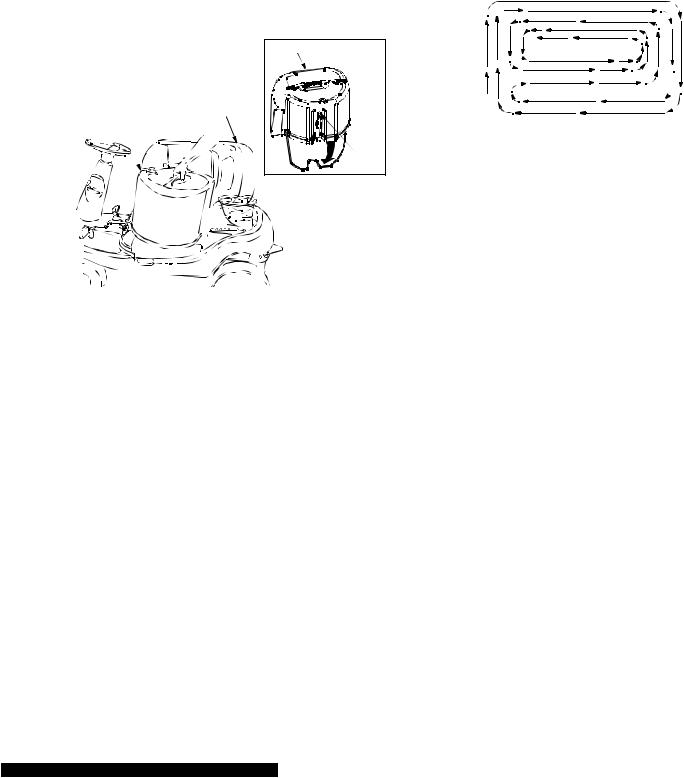
•Pivot the cover up. Pull up the grasscatcher bag by the handle and take it to the proper disposal site. See Figure 10 .
•Hold the bag away from your body. Push down on the bag lever and let the bottom section of the bag fall downwards. The grass clippings will be disposed of from the bottom. See Figure 10 .
•Tap the bag on the ground so that the three legs of the bag press against the ground. The bag lever should snap close while you push the bag downwards.
•Replace the bag on to the mower making sure the bag is placed on the flange on top of the discharge chute. Pivot the cover down.
Bag Handle
Seat
Grass Catcher Frame
Bag
Push here
Figure 10
Using The Mower
Observe safety rules listed on pages 3-5 of this manual for safe operation of your mower.
•Before mowing, make sure that the cutting deck is leveled. For deck adjustment, refer to page 14.
•You can engage the blade by pressing on the blade engagement pedal with your left foot while sitting on the operator’s seat.
•When mowing an area for the first time, watch out for objects lying on the grass. If you strike a foreign object, stop the engine. Remove wire from spark plug and thoroughly inspect the mower for any damage. Repair the damage before operating it again.
•Avoid scalping the lawn by adjusting the cutting height upwards and/or sharpening the blades.
•Mow at full throttle. Learn the terrain on which you are mowing. For best mowing results, mow only when the grass is dry.
•The recommended mowing pattern is given below:
•Mow grass often and in regular intervals so that you can cut only 1/3 of the grass blade in one mowing.
•To empty grass bag, stop the mower completely, engage the parking brake, and turn the ignition off. This will prevent the hot engine exhaust gas from browning the grass.
•Many communities no longer haul grass clippings to landfills. Composting the clippings from your grass catcher is a viable solution. For this you will have to empty the grass catcher at the designated composting site.
•Your rider mower is equipped with a mulching plug to mulch the grass and recycle into the lawn instead of collecting in the grasscatcher bag.
•Mulch only when the grass is dry. Mulching wet grass may damage the underside of the deck because wet grass tends to stick to it. Clean deck thoroughly if you mulch wet grass.
•For effective mulching, overlap mowing paths so that the clippings are distributed evenly.
12
